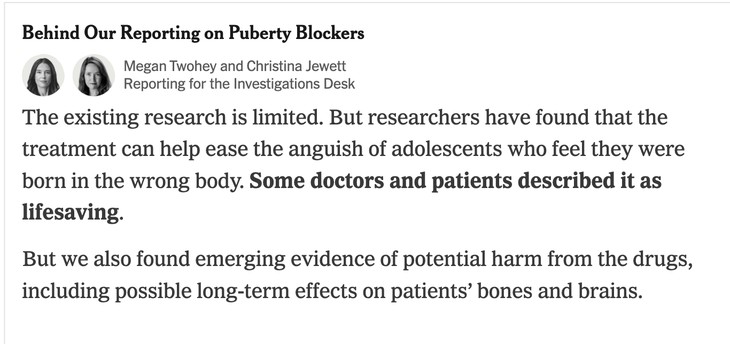Now that the election is over the propagandists at the New York Times are allowing glimpses of basic reality to slip into their reporting.
Don’t get me wrong: Republicans are still evil and all that, but maybe, just once in a very very very long while we might have a point about something….
Let me start at the beginning: The New York Times set its investigative team on the question: do puberty blockers–described by doctors as merely putting a harmless “pause” on puberty to allow children to figure out their gender issues–actually harm kids?
Seems like an important issue. All the “best” gender affirming doctors make the claim that they are perfectly safe, harmless, and helpful to children. Failure to use them is tantamount to child abuse. States like California are making themselves havens for parents who kidnap their children to give them these treatments. (The article linked below in the tweet is to the MSN version of the story, which is not paywalled for those of you who do not subscribe to the Times.)
"There is emerging evidence of potential harm from using blockers, according to reviews of scientific papers and interviews with more than 50 doctors and academic experts around the world."
Things you wouldn't have read in the New York Times a year ago. https://t.co/0TWOhYjUOR
— Varad Mehta (@varadmehta) November 14, 2022
Up until today–almost a week past the midterms in which transgender “care” was one of the issues–questioning the “full speed ahead” messaging on “gender affirming care” was proof positive that one was a Nazi sympathizer. The President of the United States himself met with transgender advocates and wholeheartedly endorsed the transgender agenda; Leftist governors across the country attacked their opponents as “transphobes” and haters for questioning the obviousness of drugging and mutilating children as health care.
“Gender affirming care” was settled science. Until today.
It turns out that when you look into it, it is voodoo. Not exactly what it is being advertised as. Maybe those nasty Republicans are right on this one?

Guess which of these two statements is closer to the truth after looking into the issue? Just guess.
The Times’ analysis begins with the case for and claims by the gender bending doctors:
As the number of adolescents who identify as transgender grows, drugs known as puberty blockers have become the first line of intervention for the youngest ones seeking medical treatment.
Their use is typically framed as a safe — and reversible — way to buy time to weigh a medical transition and avoid the anguish of growing into a body that feels wrong. Transgender adolescents suffer from disproportionately high rates of depression and other mental health issues. Studies show that the drugs have eased some patients’ gender dysphoria — a distress over the mismatch of their birth sex and gender identity.
“Anxiety drains away,” said Dr. Norman Spack, who pioneered the use of puberty blockers for trans youth in the United States and is one of many physicians who believe the drugs can be lifesaving. “You can see these kids being so relieved.”
Frankly I find this unsurprising. If one is suffering deeply any intervention can provide a ray of hope. Talk to a doctor dealing with a depressed patient who is admitted into a mood disorders clinic (psychiatric hospital); they will tell you that almost all patients experience intense relief just by entering care. At least if they were admitted voluntarily. Hope replaces hopelessness, at least for a while.
So nothing surprising about a depressed and anxious teen being relieved by entering care. Totally normal. This is also why placebos can work to make people feel better. In this case the relief isn’t coming from the drug, but from being treated at all. Any treatment is better than no treatment psychologically, at least at first.
But as an increasing number of adolescents identify as transgender — in the United States, an estimated 300,000 ages 13 to 17 and an untold number who are younger — concerns are growing among some medical professionals about the consequences of the drugs, a New York Times examination found. The questions are fueling government reviews in Europe, prompting a push for more research and leading some prominent specialists to reconsiderat what age to prescribe them and for how long. A small number of doctors won’t recommend them at all.
And here is the issue: teens experiencing any kind of “dysphoria” around their gender are being offered relief from the anxieties of being pubescent–but are the treatments offering that relief beneficial in the long run, or merely treating immediate anxiety relief for long-term health problems?
Let’s stop here for a moment and consider the case that has been made for using puberty blockers. It is not just that there is some evidence that giving kids these drugs can give them some immediate relief from depression and anxiety; the same could probably be said of a placebo, since the drugs involved are not treating the anxiety and depression. They are doing something completely different.
So if their “treatment” benefit is separate from their biological effects one has to wonder: are those biological effects benign or harmful to their physical well being? Could there be more benign ways to deal with the mental health issue (and dysphoria is a mental health issue–it is a feeling, not a physical defect like a deformity)? Can we relieve the dysphoria without harming the physical health of the patient? Are the side effects of the treatment utterly benign, even non-existent as has been claimed?
The promise of puberty blockers is that their effects are both benign and easily reversed. That is the claim by the gender bending doctors, and that claim is a total lie. There not only is no scientific evidence that this is the case–as claimed–but the scientific evidence indicates the opposite.
Dutch doctors first offered puberty blockers to transgender adolescents three decades ago, typicallyfollowing up with hormone treatment to help patients transition. Since then, the practice has spread to other countries, with varying protocols, little documentation of outcomes and no government approval of the drugs for that use, including by the U.S. Food and Drug Administration.
But there is emerging evidence of potential harm from using blockers, according to reviews of scientific papers and interviews with more than 50 doctors and academic experts around the world.
The Dutch doctors were doing experimental medicine. By the time it spread around the world the practices they pioneered were presented as the gold standard of care, despite there being essentially no evidence to back it up. None. Zip. Nada. As the Times itself puts it, little documentation of outcomes and no government approval of the drugs for that use.
“Gender affirming care” is not based on a lick of science. It is based upon hopes, feels, ideology, and no research at all. The people engaged in the practice of this medicine are witch doctors with modern tools or Lysenkoists whose ideological commitments preclude paying attention to evidence.
Many physicians in the United States and elsewhere are prescribing blockers to patients at the first stage of puberty — as early as age 8 — and allowing them to progress to sex hormones as soon as 12 or 13. Starting treatment at young ages, they believe, helps patients become better aligned physically with their gender identity and helps protect their bones.
But that could force life-altering choices, other doctors warn, before patients know who they really are. Puberty can help clarify gender, the doctors say — for some adolescents reinforcing their sex at birth, and for others confirming that they are transgender.
“The most difficult question is whether puberty blockers do indeed provide valuable time for children and young people to consider their options, or whether they effectively ‘lock in’ children and young people to a treatment pathway,” wrote Dr. Hilary Cass, a pediatrician leading an independent review in England of medical treatments of adolescents presenting as transgender.
By blocking puberty you are not just stopping the development of sexual organs; you are interfering in a complicated process that affects the entire body. Anybody who remembers puberty or has witnessed kids go through it knows that the process changes everything about the body, not just sexual function:
Many doctors treating trans patients believe they will recover that loss when they go off blockers. But two studies from the analysis that tracked trans patients’ bone strength while using blockers and through the first years of sex hormone treatment found that many do not fully rebound and lag behind their peers.
That could lead to heightened risk of debilitating fractures earlier than would be expected from normal aging — in their 50s instead of 60s —and more immediate harm for patients who start treatment with already weak bones, experts say.
“There’s going to be a price,” said Dr. Sundeep Khosla, who leads a bone research lab at the Mayo Clinic. “And the price is probably going to be some deficit in skeletal mass.”
Oops. We don’t know how big a deal this will be, but it sure isn’t exactly as advertised. Women dealing with osteoporosis later in life tend not to love the problems it brings, and with good reason. Falling and breaking a hip can prove fatal when you get older. We simply don’t have a clue what impact puberty blockers will have in the coming years on any number of body systems. Because we have no data yet.
In Europe, where these treatments were pioneered, the recent trend has been a sharp turn away from gender affirming care because it is becoming clear that the results are far from benign, and the pioneers far from honest. Yet here in the United States the Left and its Democrat Party allies are going full steam ahead.
On her [Dr. Hilary Cass’] recommendation, England’s National Health Service last month proposed restricting use of the drugs for trans youths to research settings. Sweden and Finland have also placed limits on the treatment, concerned not just with the risk of blockers, but the steep rise in young patients, the psychiatric issues that many exhibit, and the extent to which their mental health should be assessed before treatment.
In the United States, though, there is no universal policy, and the public discussion is polarized.
Republican governors and lawmakers in more than a dozen states are working to limit or even criminalize the treatments, as some in their party also seek to restrict access to sports and bathrooms, ban discussion of gender in public schools, and call into question whether transgender identity even exists. (This month, the Florida medical board banned medications and surgeries for new patients under 18.) Meanwhile, the Biden administration describes transgender medicine as a civil right. And some advocates criticize anyone who questions the treatments’ safety.
Knowing what the Times lays out–and there is much, much more in the investigation–who would you say is closer to correct? Those who want to put a brake on the headlong rush to trans kids, or those who call it a civil right and want to push every insurance company in America to fund it universally?

There is no scientific evidence telling us that the benefits are real and long lasting, but lots out there that seems to indicate that it is dangerous and experimental, not gold-standard care. Bones and brains aren’t insignificant, and lost body parts don’t grow back.
As with COVID policies, gender affirming case discussions have been entirely political. The powers-that-be have used “compassion” for children as a political cudgel to attack their political enemies, harming children permanently in the process. Their behavior has been cruel, evil, and purely self serving.
And in both cases the people who are going to pay the price are the children who are victims, not the perpetrators who have caused incalculable damage.
When the New York Times finally gets around to telling the full story, including naming names and fully admitting that people have been lied to (they are still a long way off, but moving in the right direction), excuses will be made, accountability will be passed over, and somehow Republicans will be blamed nonetheless.
Sure, we were right. But for the wrong reasons.







